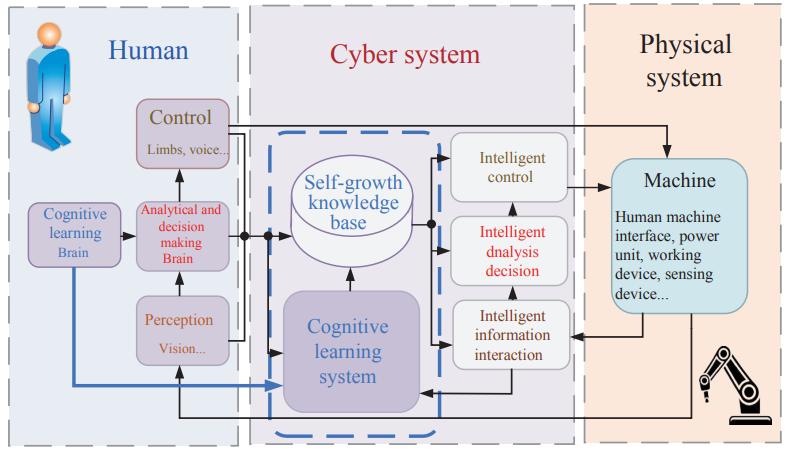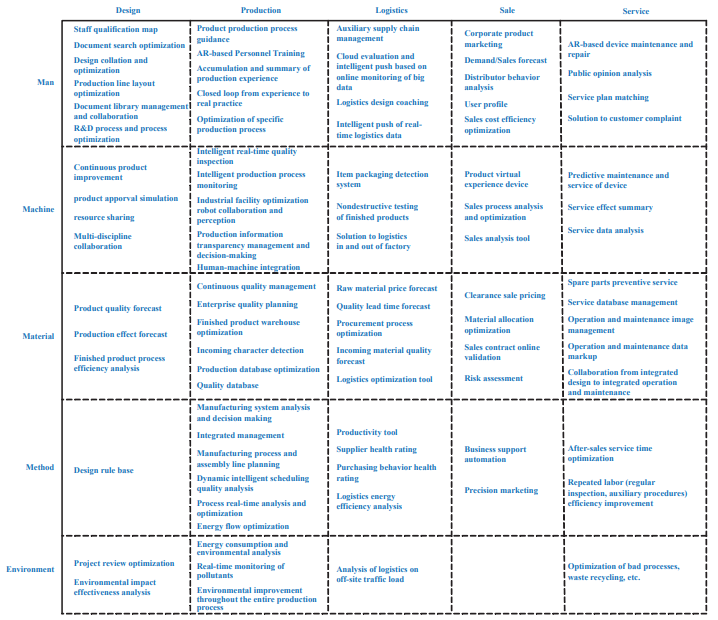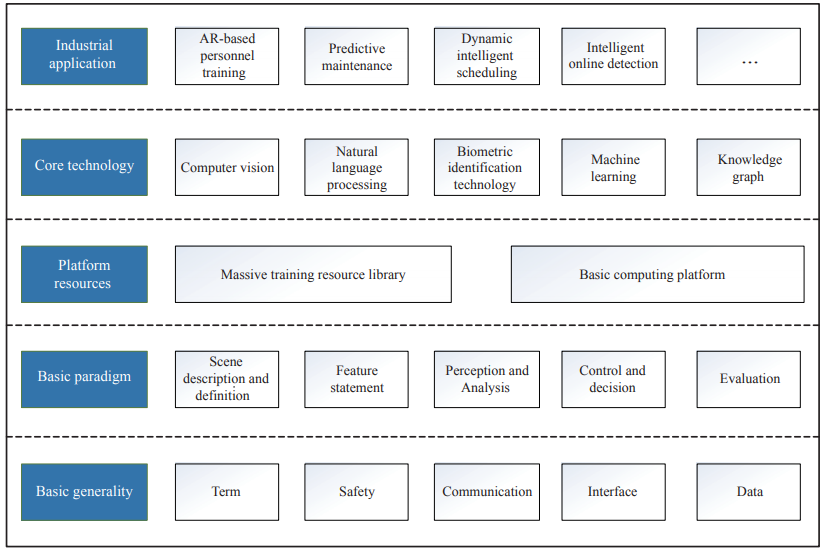《1 Introduction》
1 Introduction
In recent years, with the further integration of artificial intelligence (AI) with the manufacturing industry, AI is witnessing increasing adoption in intelligent manufacturing. Manufacturing powerhouses such as the United States, Germany, and France have introduced relevant policies to support their AI development. In August 2017, China released the Next-Generation Artificial Intelligence Development Plan and the Three-Year Action Plan for Promoting the Development of Next Generation of Artificial Intelligence Industry (2018−2020). These clearly set the goal of further integrating AI with the manufacturing industry and accelerating China’s evolution toward manufacturing power and Internet power by focusing on deeply integrating IT with manufacturing technology and highlighting the industrialization and integrated application of next-generation AI technology.
However, China’s AI is still much inferior to its foreign counterparts in terms of its level of application in intelligent manufacturing. Moreover, the essential relevant standards are still not available. Therefore, based on an analysis of the typical AI application scenarios in intelligent manufacturing, we shall summarize the application systems of AI in intelligent manufacturing, analyze the existing problems, and predict future development trends. We will also study the impact of generic technologies and related applications involved with the key performance indicators (KPIs) of enterprises to extend a standard system of AI for the field of intelligent manufacturing. This is critically important for promoting the deep integration of AI with the manufacturing industry in China, thus improving intelligent manufacturing capability and intelligent manufacturing standards system in the country.
《2 Intelligent manufacturing system architecture and implementation》
2 Intelligent manufacturing system architecture and implementation
《2.1 Intelligent manufacturing system architecture 》
2.1 Intelligent manufacturing system architecture
The analysis of the technology mechanism [1] of next-generation intelligent manufacturing shows that, compared with the traditional manufacturing system, cyber systems are added between human and physical systems in the first-generation and second-generation intelligent manufacturing systems. In these updated manufacturing systems, human partial perception, analysis, and decision-making functions have been replicated within and migrated to the cyber system. People can control the physical system through the cyber system, thus replacing manual labor with controlled physical systems. The next-generation intelligent manufacturing systems, in particular, include cognitive and learning functions that are added based on first- and second-generation intelligent manufacturing systems. In addition to the abilities of perception, computational analysis, and physical control, such cyber systems possess the capability of learning, improving, and generating knowledge.
The next-generation intelligent manufacturing system architecture is shown in Fig. 1.
《Fig.1》

Fig. 1. Next-generation intelligent manufacturing system architecture [1].
《2.2 KPIs for intelligent manufacturing 》
2.2 KPIs for intelligent manufacturing
By integrating the advantages of human, cyber, and physical systems, the next-generation intelligent manufacturing systems can help enterprises significantly improve their productivity, quality, and stability. Moreover, they can effectively improve the efficiency of inheritance and utilization of human knowledge. Reference documents [2,3] show that the KPIs of enterprises are quantitative management indicators for measuring their performance. Therefore, the impact of intelligent manufacturing systems on enterprises can be described with various KPIs such as passed yield, efficiency, overall device effectiveness (OEE), and delivery cycle. For example, OEE represents the ratio of the actual production capacity of a device to its theoretical capacity [4,5].
《2.3 Exploration of how to realize an intelligent manufacturing system》
2.3 Exploration of how to realize an intelligent manufacturing system
Because enterprises are the carriers of intelligent manufacturing systems, one of the basic transformation and upgrade demands of enterprises is to improve profitability and competitiveness by building intelligent manufacturing systems. Based on the above factors, next-generation intelligent manufacturing system architecture, an enterprise system hierarchy, and enterprise KPIs are shown in Fig. 1. The form of implementation of an intelligent manufacturing system can be illustrated by a closed-loop system with the enterprise as the core, as shown in Fig. 2.
《Fig.2》

Fig. 2. Exploration of how to realize intelligent manufacturing systems.
In the exploration of how to achieve intelligent manufacturing systems as shown in Fig. 2, the enterprise is driven by market demand, it deeply explores the individual needs of customers, and it continuously monitors the deviation between the KPIs of the enterprise and its expected indicators during the product life cycle. Based on the above information and the company’s own production and management data, among others, we shall integrate and converge information in the cyber system, analyze the existing problems of enterprises, and come up with corresponding strategies for solving relevant problems. This will be done using iterative optimization through such methods as virtual simulation verification. Subsequently, we will adjust all aspects of the whole lifecycle (e.g., actual product design, production, and logistics), thus ultimately achieving horizontal integration, vertical integration, end-to-end integration, and improving the various KPIs, profitability, and competitiveness of enterprises.
《2.4 The main roles of AI technology in intelligent manufacturing 》
2.4 The main roles of AI technology in intelligent manufacturing
The application of AI technology in each aspect in Fig. 2 is the foundation for realizing next-generation intelligent manufacturing systems. In terms of demand analysis, the application of such AI technology as user profile and public opinion analysis can help enterprises improve their accuracy in analyzing demands for individualized production, thus improving their competitive advantages. In terms of the analysis of enterprise KPIs, the application of such AI technology as process efficiency analysis of finished products, logistics efficiency analysis, distributor behavior analysis, and solutions to customer complaints could provide a basis for enterprises to discover hidden problems. In terms of enterprise operation optimization, the application of such AI technology as advanced production scheduling, production line layout optimization, process analysis and optimization, and finished product warehouse optimization could provide auxiliary decision-making for enterprises to optimize and adjust production, logistics, and other aspects. In terms of the product lifecycle control, the application of such AI technology as personnel training and intelligent online detection based on augmented reality (AR) technology can improve the efficiency and quality of product design, production, and other aspects.
In summary, with its wide application in all aspects of intelligent manufacturing systems, AI technology can help further improve the efficiency of manufacturing systems and product quality. It could provide optimization and a decision-making basis for enterprise operations, reduce the workloads of enterprise personnel, improve the KPIs of enterprises, and guide manufacturing enterprises towards self-perception, self-decision-making, and self-implementation.
《3 Typical application scenarios of AI technology in intelligent manufacturing 》
3 Typical application scenarios of AI technology in intelligent manufacturing
《3.1 Typical application matrix》
3.1 Typical application matrix
According to the analysis in the first section, AI technology has been applied in certain fields of intelligent manufacturing. By taking into account both the location of the relevant applications in the product lifecycle and the impact on the key factors of the total quality management of a product, Fig. 3 illustrates the typical application matrix of AI in intelligent manufacturing from a two-dimensional perspective, based on such key factors as Man, Machine, Material, Method, and Environment.
Fig. 3 shows that the generic technologies involved when AI is applied in intelligent manufacturing include machine learning, biometric identification technology, computer vision, natural language processing, and knowledge graphs. Simultaneously, the above applications mainly target such specific and repetitive problems as product quality inspection, process analysis, and optimization. Furthermore, they provide auxiliary optimization and auxiliary decision-making for enterprise managers or workshop operation and maintenance personnel. This would help enterprises improve their productivity and reduce the workloads of their personnel.
《Fig.3》

Fig. 3. A typical matrix for applications of AI in intelligent manufacturing.
《3.2 Typical applications of AI in production 》
3.2 Typical applications of AI in production
Typical applications of AI include AR-based personnel training, predictive maintenance, dynamic intelligent scheduling, intelligent online detection, energy consumption, and environmental analysis.
In traditional training modes, trainees can hardly achieve expected effects due to such factors as lack of flexibility, mobility, difficulty in understanding, and high cost. In contrast, AR devices can improve the above problems by providing trainees with real-time, on-site, systematic guidance. In the field of product assembly, in particular, AR devices can instruct operators to complete the required steps by converting the drawings into a visual 3D model. Taking Boeing as an example, the AR-based Boeing 737 engine assembly and troubleshooting system improved assembly efficiency by approximately 20%, with the improvement of one-time assembly accuracy by approximately 24% [6,7].
With a traditional production line, a large number of defective products may have been produced from a time that a production device breaks down, before an alarm is triggered. The enterprise will inevitably suffer great losses. Predictive maintenance, in contrast, can identify faulty devices and repair them in advance based on the device operation data collected in real time and identify fault signals using machine learning algorithms. Ultimately, this will help reduce the maintenance time and cost required by devices, improving the device utilization rate and avoiding the losses caused by device failure [8,9].
With the traditional manual scheduling mode, there is usually a high workload, high dependence on personnel, and numerous complicated processes that may lead to unreasonable production planning and low efficiency. The intelligent scheduling system, with such AI technology as machine learning algorithms, helps enterprises integrate and optimize resources and systems, and achieve dynamic optimized scheduling. It can help enterprises achieve on-demand production, improve operational efficiency, shorten product cycles, and increase production capacity. Taking elevator manufacturing companies as an example, a dynamic intelligent scheduling system was able to reduce planning time by 75% [10,11].
With traditional quality control mode, the detection of the surface defects of a product, internal crack inspection, and edge and other defects mainly depends on human eyes. Operators are likely to get fatigued under such a heavy workload, resulting in a high defect rate, especially in such sensitive sectors as chips, home appliances, and textiles. Based on product photographs collected by the sensors, intelligent online detection technology could detect defective products using computer vision algorithms. This would improve the detection speed and quality of the products, and avoid losses caused by missed detection and false detection. Taking chip companies as an example, the application of such technology could greatly reduce the defect rate. It could also reduce the scrap rate by analyzing the root cause of defective products and optimizing the product design and production processes to further reduce the cost of testing [12].
《4 Research toward a standards system of AI technology in intelligent manufacturing 》
4 Research toward a standards system of AI technology in intelligent manufacturing
《4.1 standards system of AI technology in intelligent manufacturing 》
4.1 standards system of AI technology in intelligent manufacturing
With the further integration of AI technology, next-generation information technology, and new professional manufacturing technology in the field of intelligent manufacturing, AI standards could be used to guide the application of AI technology in all aspects of the life cycle. This would guarantee its reliability and security in intelligent manufacturing applications, to meet the demands for intelligent development throughout the manufacturing lifecycle.
In view of the increasing application of AI technology in intelligent manufacturing, it is increasingly urgent and necessary to develop AI standards. According to the National Intelligent Manufacturing Standards System Construction Guideline [13], AI application standards should include scene description and definition standards, knowledge base standards, performance evaluation standards, and intelligent online detection, swarm intelligence-based personalized innovative design, collaborative R&D swarm intelligence space, intelligent cloud production, intelligent collaborative assurance, supply marketing service chains, and other application standards. According to the typical application scenarios of AI in intelligent manufacturing and the generic technologies involved, as well as intelligent manufacturing requirements (such as security and interconnection of related applications), the above AI application standards could be further developed into a standards system architecture for AI in intelligent manufacturing, as shown in Fig. 4. This would include basic generality, basic paradigm, platform resources, core technology, and industrial applications.
《Fig.4》

Fig. 4. Standards system architecture diagram of AI in intelligent manufacturing.
《4.2 Research progress toward developing standards》
4.2 Research progress toward developing standards
The International Organization for Standardization (ISO), International Electrotechnical Commission (IEC), ISO/IEC JTC1, ITU-T, Institute of Electrical and Electronics Engineers (IEEE), as well as the China National Information Technology Standardization Network, China National Technical Committee for Industrial Process Measurement, Control and Automation Standardization, China National Technical Committee for Automation Systems and Integration Standardization, and other international and domestic standardization organizations have made great efforts toward AI standardization. They have jointly published Information Technology−Vocabulary−Part 28: Artificial Intelligence−Basic Concepts and Expert System, Information Technology−Vocabulary−Part 29: Artificial Intelligence Speech Recognition and Synthesis, Information Technology− Vocabulary−Part 31: Artificial Intelligence Machine Learning, Information Technology−Vocabulary−Part 34: Artificial Intelligence Neural Network, and other national standards. They have also initiated many standardization projects such as transparency of autonomous systems, data privacy processing, and algorithm deviation considerations [14].
At present, there are still relatively few standards concerning AI in the field of intelligent manufacturing. The IEEE standard proposal named Standard for General Requirements of Online Detection Based on Machine Vision in Intelligent Manufacturing, which was submitted by China Electronics Standardization Institute and other research institutions, was reviewed and approved at the IEEE NesCOM on December 7, 2017, and a relevant project has been officially approved (Project No. P2671).
《5 Conclusions 》
5 Conclusions
According to the above analysis, AI technology will play a vital role in promoting the development of China’s next-generation intelligent manufacturing system and the improvement of enterprise KPIs. Moreover, it has been widely adopted in various aspects of the product lifecycle. However, the rather limited number of AI standards now available in the field of intelligent manufacturing in China can hardly meet the current demands of AI technology for standardization and are unfavorable for the orderly, standardized, and healthy development of AI applications in China. China’s great effort in rapidly advancing intelligent manufacturing standardization has laid a solid foundation for the wide application of AI in intelligent manufacturing. Based on this, more effort should be made to further transform and upgrade China’s manufacturing sector, with top priorities to be given to research on scene description and definition, knowledge base, performance evaluation, typical industrial applications, and other relevant standards. These should be based on the application status and future development needs of AI technology in intelligent manufacturing, combined with the deployment as required of such important documents as Next-Generation Artificial Intelligence Development Plan, Three-Year Action Plan for Promoting the Development of Next Generation of Artificial Intelligence Industry (2018−2020), and National Intelligent Manufacturing Standards System Construction Guideline.













 京公网安备 11010502051620号
京公网安备 11010502051620号




